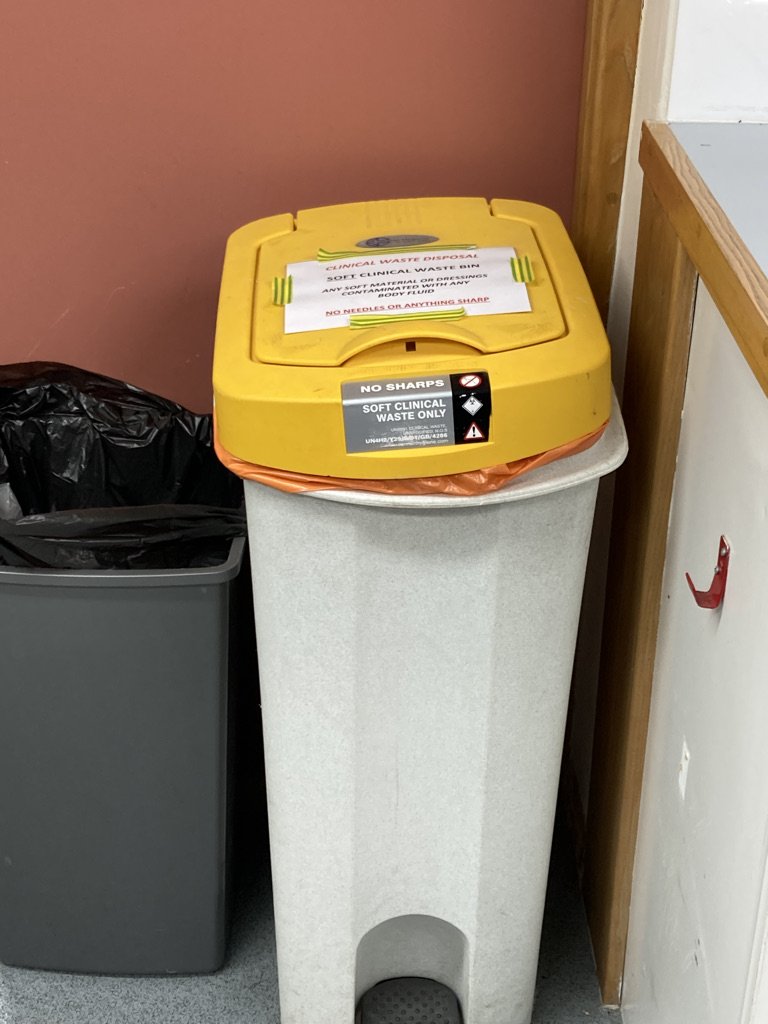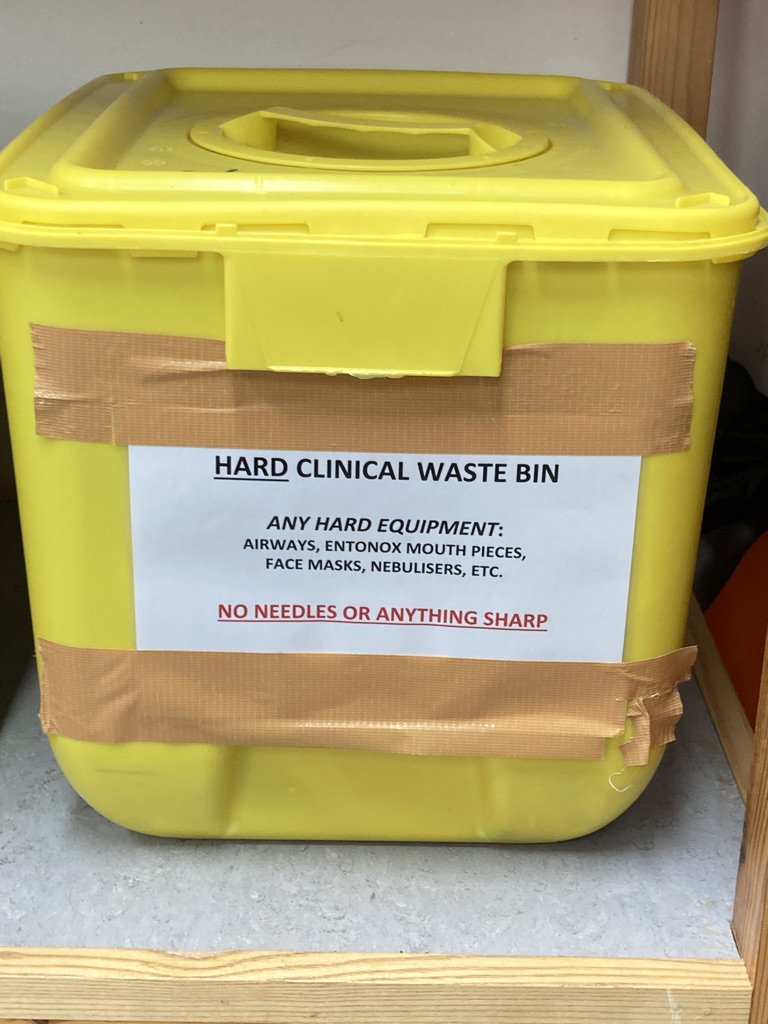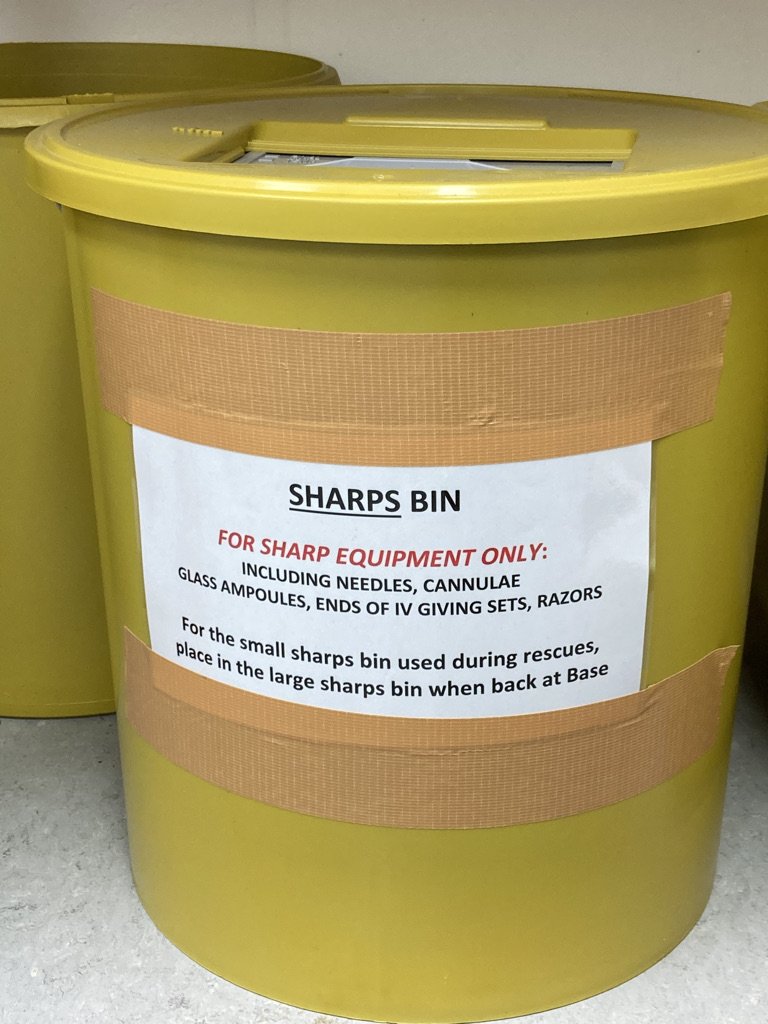Updated 21/2/25
SHARPS INJURY & CLINICAL WASTE MANAGEMENT
The major concern with sharps injuries is the risk of blood born infection. The three most common infections in the UK are HIV, Hepatitis B and Hepatitis C viruses.
‘Sharps’ are needles, intravenous cannulae and medical instruments, that could cause an injury by cutting or pricking the skin. A sharps injury is an incident, which causes a needle or other medical instrument to penetrate the skin. A ‘safer sharp’ means a medical sharp that is designed and constructed to incorporate a feature or mechanism which prevents or minimises the risk of accidental injury from cutting or piercing the skin if used correctly.
Anyone who comes into contact with a sharp instrument previously used on another person is at risk. In mountain rescue, team members and support staff can be put at risk of injury in two ways: those who directly handle sharps and those who may inadvertently be put at risk when sharps are not handled, stored, or disposed of correctly.
Risks arise from sharps during casualty care and following administration of drugs by intramuscular injection and intravenous cannulation. The risk occurs in the following ways:-
during use on a rescue
after use, before disposal
between steps in procedures
during disposal
whilst re-sheathing or recapping a needle.
misuse of sharps storage boxes kept in the equipment and medical training rooms and medical sacs
General principles for safe handling of sharps
i) Safe use of sharps bins (pictures of bins below)
Sharps containers should comply with the UN3291 and British Standard BS7320.
The correct size sharps container to be used should be determined according to the volume of sharps generated.
Sharps containers should not be used for any other purpose than the disposal of sharps. A sharp for disposal would be needle, glass, and cannula not syringes and dressings.
Never press down the contents to make more room or attempt to retrieve an item from the sharps container.
After disposing of a sharp into the sharps container, the aperture should be moved into the temporary closure ‘closed’ position. The aperture must be ‘locked’ prior to disposal.
Sharps containers must not be filled above the ‘fill line’ as this could result in sharps protruding through the aperture.
Sharps containers must not be placed inside waste bags prior to disposal.
3/4 full sharps containers should be placed in a safe space ready for collection. For LAMRT Ada’s Nook is used and the Equipment Officer notified to arrange disposal.
ii) Safe use of sharps
Do not carry unguarded sharps in the hand. Sharps containers should be available at the point of use, i.e. where the sharp is used.
Sharps should be placed into the sharps container by the person using them.
Safety needles must be used and the safety device must be applied before disposal. Training in the use of these devices will be essential for all Cas Carers.
Do not pass sharps from hand to hand.
Do not recap needles. Dispose of needle and syringe as one unit into a sharps container.
Always carry sharps containers away from the body, ensuring the temporary closure mechanism is activated.
iii) Personal protective equipment
Appropriate personal protective equipment will be worn when carrying out clinical procedures. Nitrite gloves must be worn for all activities that have been assessed as carrying a risk of exposure to blood and body fluids and when handling sharps or contaminated devices. Gloves will not protect against a needle stick injury but the wiping of the blood through the glove can substantially reduce the volume of blood inoculated in the event of the needle stick injury.
In addition, all team members should protect their skin, as skin is an effective barrier to microorganisms. Any cuts or abrasions should be covered with an impermeable dressing to provide a barrier before undertaking a risk-prone procedure.
iv) Training
All team members will receive appropriate training which will cover, where relevant:
the risks associated with blood and body fluid exposures
preventive measures including standard precautions
safe systems of work
the correct use and disposal of sharps
the correct use of medical devices incorporating sharps protection mechanisms
actions to take in the event of an injury.
v) First Aid in the event of an injury
The injury will have occurred on the hill, in a vehicle or at Base. Immediate action must be to:
BLEED IT - if there is a puncture wound, encourage bleeding of the wound by squeezing it under running water (do not suck the wound).
WASH IT - the injured area or damaged skin should be washed thoroughly with liquid soap and warm running water (do not rub) and dried. On the hill use the wound cleansing wipes.
Blood or body fluid splashes to the eyes, nose or mouth should be irrigated copiously with water.
COVER IT - cover the wound with a waterproof dressing.
REPORT IT- during a rescue, report the injury immediately to the team leader or healthcare professional on the rescue and complete an incident form on return to Base and notify the medical officer.
SEEK ADVICE – The medical officer will make an assessment and advise further care if appropriate.
vi) Learning from incidents
Every sharp or needle-stick incident will be investigated to ensure that as an organisation, we learn from incidents and that relevant issues are addressed in order to prevent a recurrence or reduce the risk of another event occurring.
In addition, any event in which it is identified that an injury could have occurred (near miss) or where a sharp or needle has been stored or disposed of unsafely must be reported immediately to the medical officer. The incident can be reported anonymously, but it must be reported. This can be by email, WhatsApp or phone to the Medical Officer.
vii) LAMRT sharps & clinical waste equipment
The safety device needles we carry are in the injection pouch of the medical sac. There are 2 types: a safety needle for injection and a blunt fill needle with filter for drawing up the solution. Here are two videos showing you how they are used.
The Blunt Fill filter needle video
NB this will end abruptly because it goes on to talk about additional info that is not relevant to LAMRT practice.
The Safety needle for IM injections video - LAMRT needles are green (21G) or blue (23G). We use the green for I.M injections unless the casualty is very thin, then the blue (shorter needle) can be considered.
CLINICAL WASTE DISPOSAL
All the sharps and soft clinical waste bins are kept in the Equipment Room. The picture below shows you the layout of the ‘Sharps’ box and ‘Hard’ clinical waste boxes. The ‘Soft’ clinical waste bin is on the corner by the door.
There are 3 types of disposal bins/boxes:-
i) SOFT CLINICAL WASTE BIN
This is for any soft material or dressings contaminated with any body fluid. NO NEEDLES OR ANYTHING SHARP
ii) HARD CLINICAL WASTE BIN
This is for any hard equipment, for example, airways, entonox mouth pieces, face masks, nebulisers etc NO NEEDLES OR ANYTHING SHARP
iii) SHARPS BIN
This is for sharp equipment only, including needles, cannulae, glass ampoules, ends of IV giving sets, razors (when applying defib pads) For the small sharps bin used during rescues, place in the large sharps bin when back at Base
Small sharps box
This box is in the medical sac‘s Injections Pouch. When this box is 3/4 full it is disposed off in the large sharps box in the Equipment Room.
IMPORTANT NOTES FOR ALL BINS
Never press down the contents
Do not leave the lid open of any of the clinical waste bins. Whilst in use, ensure the sliding lid closures are in the ‘closed’ but not ‘locked position
Do not fill containers above the ‘fill line’ or fill up to ¾ if no line
Full containers must be locked. Place in Ada’s Nook and notify the Equipment Officer to arrange removal.




